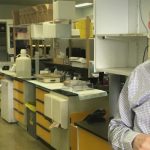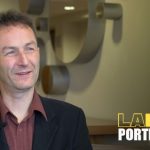
Professor of Molecular Cell Biology, Royal Holloway University of London
In the third interview of our series “Portrait of Duchenne”, La Fondation La Force talks with George Dickson, Professor of Molecular Cell Biology at the Royal Holloway University of London. He has spent most of his career studying neuromuscular disease and muscle cell biology, contributing to, the first cloning of an intact dystrophin gene, the discovery of the role of cell adhesion molecules in muscle stem cell fusion, the first identification of utrophin and the first description of exon skipping in Duchenne muscular dystrophy (DMD).
Our journey at La Fondation La Force travels the road of discovery with families, researchers, pharmaceutical companies and more. Our mission is finding the best new experimental treatments and the most promising research for children and adults with Duchenne muscular dystrophy (DMD). In November 2016, we went to the 14th Action Duchenne International Conference in London, UK, to meet with the international DMD community on your behalf. We hope this series of interviews will bring hope and inspiration to Canadian families.
Developing new treatments for DMD
For the past decade, Dr. Dickson’s team has been involved in developing exon-skipping drugs, specifically for exons 53, 45 and 46. They did not work on developing the exon 51-skipping drug eteplirsen (Exondys 51™; Sarepta Therapeutics Inc.), which is approved for use in the USA, but did contribute to early clinical trials in the UK. They also work in parallel on developing gene therapy tools called recombinant dystrophin genes.
In the video, Professor George Dickson answers our questions about gene therapy & exon-skipping drugs.
1— Can you explain the basis of gene therapy?
R: It’s really very simple. Many genetic conditions are caused by the damage and, basically, the absence of particular genes. In DMD, it’s the dystrophin gene. Perhaps one way of treating those conditions – one very simple, one obvious way – would be to replace the missing gene with a version which has been created – a functional version that’s been created in the laboratory. That is basically the aim of gene therapy.
2— Which treatments are you working on in your laboratory?
R: In the case of Duchenne, we’ve been involved for maybe 10 years now in developing some of these exon-skipping drugs, not exon 51, not the eteplirsen, which has now been approved, but some of the others that are coming through behind for exon 53 and 45 and 46. We have reagents that we’ve developed that are in clinical trial. And, at the same time, we’ve worked on developing the gene therapy tools for DMD– which are called recombinant dystrophin genes, the largest genes that allows us to plan ahead for clinical trial.
3— When do you think the damaged DMD gene could be replaced?
R: It’s difficult to say. The honest truth is we have the genes. They are lab-based genes. We have systems to deliver the genes, and we know that the gene therapy is very active in experimental models and perhaps animal models of DMD. Now we have to scale up the process and run clinical trials of that technique in patients with Duchenne muscular dystrophy. Those clinical trials, for example, if they began right now, and we are planning to start very soon with those trials, maybe within the next 12 months, but if they began right now, they probably would take 2 or perhaps 3 years to complete and get the final results from them. So 3 years to test the product and then perhaps another year or 2 years to get official authorization for the new drug, the new medicine, to be used in patients. So in honesty, we are looking 2,3 years, perhaps 5 years ahead. But hopefully the gene therapies will be tested in patients with Duchenne muscular dystrophy well before, that perhaps, within 18 months I would say.
4— What is exon skipping?
R: Well, to try and explain it simply: the way the cell works with genes, the gene is actually separated into a number of fragments. You can imagine this like a linear jigsaw puzzle, and these fragments have to be joined together to produce the proper gene product. If there is a change in one of the fragments, which affects the way the gene works, which causes, shall we say, Duchenne muscular dystrophy or other genetic diseases, one potential way is to persuade or induce the muscle tissue to ignore the damaged fragment and join together fragments on either side. Now, a jigsaw puzzle, as you can imagine, if you don’t fit the right pieces together, will not work, so exon skipping is designed to try and ensure that the fragments that are brought together in the gene, avoiding mutation, are functionally active and, basically, that involves a medicinal product, which is a very small piece of nucleic acid, which masks the damaged jigsaw puzzle piece and allows others to come together in a functional way.
5— How do you envision the future for people with DMD?
R: My dream, I suppose you would call it that, what I feel we’re all working towards, is a situation, like in many diseases, where a combination of three of four medicines will allow Duchenne to become a disease which perhaps isn’t cured – cured is a difficult word in medicine – but what happens mostly in medicine is that conditions are managed to improve very, very much the quality of life of patients with the illness, with Duchenne muscular dystrophy. So a combination of drugs available to pediatricians to treat boys with Duchenne muscular dystrophy and produce a very significant improvement in their disease and in their quality of life. That would be fantastic, already.
Up next:
Our next portrait: Ellen Welch, group leader biology at PTC Therapeutics talks about ataluren (Translarna™).
To receive the next interview in our series “Portrait of Duchenne”, please subscribe to our newsletter.
Acknowledgements
We thank the Action Duchenne UK team, who received us with open arms and gave us access to all key speakers at their conference. Because of their generosity, we can spread this hopeful information to the Canadian DMD community.
To know more about the Action Duchenne conference:
Special Thanks to Daniel K Cooper and Allain Lagadic




